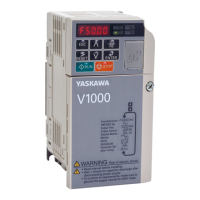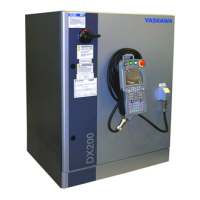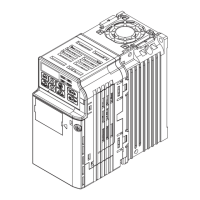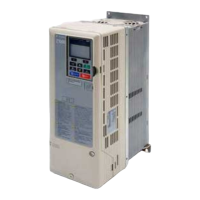5.7 H: Terminal Functions
162 YASKAWA ELECTRIC SIEP C710606 44B YASKAWA AC Drive T1000V Technical Manual
Setting C: Analog Inputs A1/A2 Enable
If a digital input programmed for this function is open, both analog inputs A1 and A2 are disabled. Close the input to
enable the inputs.
Setting F: Not Used/Through Mode
Any digital input that is not used should be set to F. When set to “F”, an input does not trigger any function in the drive.
Setting F, however, still allows the input status to be read out by a PLC via a communication option or MEMOBUS/
Modbus communications (through mode). This way external sensors can be connected to unused drive digital inputs,
thus reducing the need for separate PLC I/O units.
Setting 10/11: Up/Down Command
Using the Up/Down function allows the frequency reference to be set by two push buttons. One digital input must be
programmed as the Up input (H1-= 10) to increase the frequency reference, the other one must be programmed as
the Down input (H1-= 11) to decrease the frequency reference.
The Up/Down function has priority over the frequency references digital operator, analog inputs, and pulse input (b1-01
= 0, 1, 4). If the Up/Down function is used, then references provided by these sources will be disregarded.
The inputs operate as shown in the table below.
Note: 1. An oPE03 alarm will occur when only one of the functions Up/Down is programmed for a digital input.
2. An oPE03 alarm will occur if the Up/Down function is assigned to the terminals while another input is programmed for the Accel/
Decel Ramp Hold function. For more information on alarms, Refer to Drive Alarms, Faults, and Errors on page 239.
3. The Up/Down function can only be used for external reference 1. Consider this when using Up/Down and the external reference
switching function (H1- = 2).
Using the Up/Down Function with Frequency Reference Limits
The upper frequency reference limit is determined by parameter d2-01.
The value for the lower frequency reference limit can be set by an analog input or parameter d2-02. When a Run
command is applied, the lower limits work as follows:
• If the lower limit is set by parameter d2-02 only, the drive will accelerate to this limit as soon as a Run command is
entered.
• If the lower limit is determined by an analog input only, the drive will accelerate to the limit as long as the Run
command and an Up or Down command are active. It will not start running if only the Run command is on.
• If the lower limit is set by both an analog input and d2-02, and the analog limit is higher than the d2-02 value, the drive
will accelerate to the d2-02 value when a Run command is input. Once the d2-02 value is reached, it will continue
acceleration to the analog limit only if an Up or Down command is set.
Status
Description
Up (10) Down (11)
Open Open Hold current frequency reference
Closed Open Increase frequency reference
Open Closed Decrease frequency reference
Closed Closed Hold current frequency reference
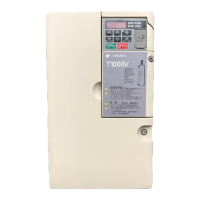
